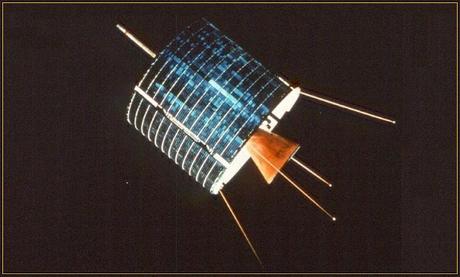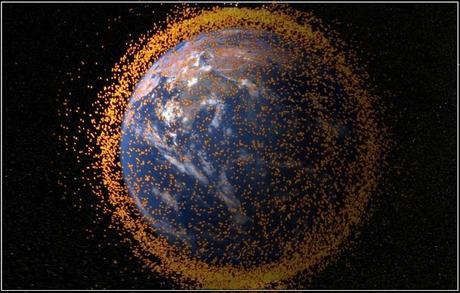The etymology of our word satellite is fairly straight-forward: it derives from the Latin satelles, an attendant (upon a distinguished person) and prior to that possibly the Etruscan satnal, a follower. It was the German astronomer Johannes Kepler who at the beginning of the 17th century applied the word satellites to moons orbiting a planet (specifically Jupiter) and the appellation stuck. It also became used to refer to small towns circling a city or small nations grouped round and dominated by a large and powerful one, but that's by the by.The first recorded usage of the word meaning 'man-made machine orbiting Earth' was in a theoretical paper of 1936 and then twenty-one years later on October 4th 1957 the theory became reality when the Soviet Union put Sputnik 1 up into orbit, where it remained until it ran out of power and fell back to Earth in the New Year. The achievement took the world (America in particular) by surprise and was the starting-signal of the space race.Since then, thousands of satellites have been put into orbit by over one hundred countries, Italy among them, and I've been sufficiently impressed by the fine lines of their modish Sirio satellite to feature it here.

Sirio - quality Italian design
Does anybody else think it looks like a stylish retro-1960s lampshade? What few people realize is that Italy was the third nation to put a satellite into space, after the Soviets and the Americans. That was the San Marco project in 1964 under the guidance of Professor Luigi Broglio.. Sirio followed a decade later. Designed and built entirely in Italy (jointly by Compagnia Industriale Aerospaziale and Telespazio), it was Italy's first TLC (telecommunications) satellite and was launched successfully into geostationary orbit on 25th August 1977. It was originally intended to be functional for approximately two years but to the delight of the Italian space agency and telecommunications companies it kept on working right up until 1987. (Unfortunately, a successor to Sirio failed to achieve Earth orbit on launch and fell back into the Atlantic.) Now no longer operational, Sirio continues to circle the earth at an altitude of 36,000k, just one of thousands of man-made celestial bodies flying round the planet (see below).
satellites attendant upon Earth (photo credit: NASA Goddard Centre)
Reading that, and thinking that space junk may be developing into an issue, I was surprised and delighted to learn that the UN has an Office for Outer Space Affairs (UNOOSA) and one of its functions is to keep track of what's going on above our heads. They record that as of 2022 (65 years into the space race), there have been in excess of 13,000 launches from 31 different facilities worldwide, Currently there are 8,261 satellites still orbiting Earth of which 4,852 are active, and over half of those are involved in telecommunications (supporting our internet and mobile phone capabilities). Sirio then is one of 3,409 'dead' satellites, a ghost rider in our skies. This little poem (subject to revision) is in tribute.Italian SpaceOnly the Italians of all races on Earth perhaps would name their space programme after a saint - San Marco. I might rather have expected Marco Polo to feature,that renaissance Venetian famed for his travels.
When I unravel it though,it turns out San Marco wasthe name of an oil platform donated by the state energy company as a launch pad.
It's funny what one assumes. ThenI wondered what 'To Boldy Go' would be in translation.
"Per Andare Corragiosamente"apparently. Now that has a prize-fighter swagger to itand they were certainly punchingabove their weight,Amaldi, Broglio and Co as theyran in a late but creditable thirdbehind the Soviets and USAto launch a satellite to the skies.
It was a bit stylish looking, like a retro designer lampshadefor some chic Italian space,a coffee house say,plate glass, chrome and leather,naturally a cool marble floor,Vespas, Lambrettas, Piaggios parked outside on the pavement,a Gaggia hissing on the barlike a reverse rocket thrusterand clustered round a tv screenmen in sharp suits sipping espressoand ladies in fresh summer frockswaiting with fingers of icefor the apogee and the ageof global telecomms to be born.
I'm taking a week's holiday from the blog, off to catch some Greek sunshine on Zakynthos, so I'll leave you with a musical bonus, Counting Crows performing Recovering The Satellites (just click on the song title, it's a hyperlink to a YouTube rendition of the title track from the band's 1996 album.) See you in two weeks.Thanks for reading, S ;-) Email ThisBlogThis!Share to TwitterShare to Facebook
